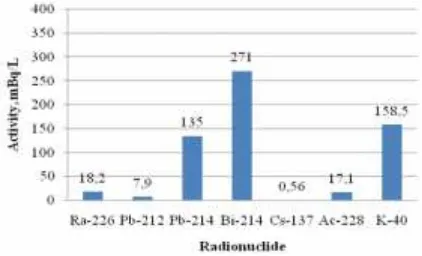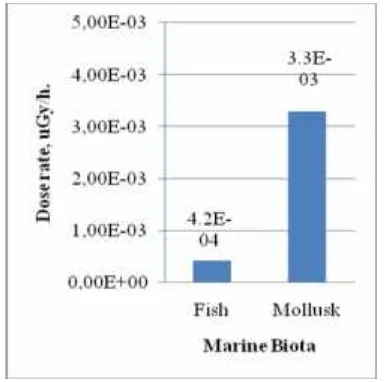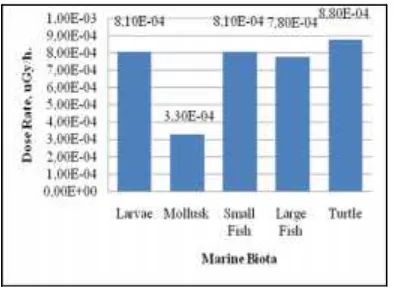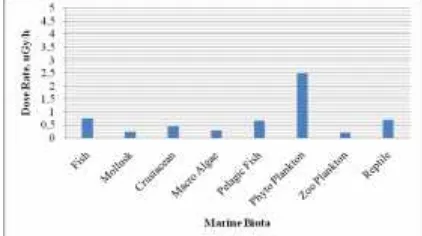1
Dose Rate of Natural Radionuclides and
137Cs in Marine Biota of Bangka Sea
Erwansyah Lubis, Heny Suseno, Wahyu Retno Prihatiningsih and M. Nur Yahya
Center for Technology of Radiation Safety and Metrology,National Nuclear Energy Agency of Indonesia Jl. Lebak Bulus Raya No. 49 Jakarta Selatan, 12440 Indonesia, E-mail : erlub@batan.go.id
Abstract.Estimation of the dose rate of natural γ radionuclide and 137Cs of sea water and marine sediment to larvae/ small insect, mollusk/large insect, small fish, large fish and turtle has been carried out using Point Source Dose Distribution (PSDD) methodology. The results indicated that total dose rate of β and γ radiations from natural radionuclides and137Cs from sea water and marine sediment to larvae/small insect, mollusk/large insect, small fish, large fish and turtle were small, around 6,03% from screening dose rate (SDR) of 100uGy/ hour. Based on these data, further investigation is not needed and this data can be used as a base-line data for marine monitoring activities if nuclear power plant (NPP) would be built and operated in Bangka islands. The total dose rate that calculated with PSDD methodology was compared using ERICA computer code, and the results indicated unsignificantly different.
Keywords: Natural Radionuclides,137Cs, Marine Biota, Dose rate, Base-line Data.
Introduction
Based on the assessment of electricity needs in Indonesia, that 5% of national electricity in the future will be supplied from Nuclear Power Plant (Blue-print of National Energy Management 2005–2025). The first of Nuclear Power Plant (NPP) was planned will be built in Bangka island. The NPP generally is built and operated close to the water-body. The water-body is used for cooling system of NPP beside as a media for releasing the liquid effluent that generated from radioactive waste processing facility (RWPF). If NPP built and operated in Bangka islands, the seawater surrounding of Bangka islands has potentially will be contaminated by the radioactive effluent released from RWPF.
In the operations of the NPP, low-level and medium-level of radioactive waste and spent fuel element will be generated. According to Indonesian Nuclear Act, the management police for high radioactive waste will be close or open cycle, are not yet decided (Act No. 10, 1997). The low-level and medium-level of radioactive waste will be processing in the RWPF that is built close to the NPP site. The spent fuel element will be stored in the nuclear site, with dry or wet stored system. In processing liquid radioactive waste the liquid effluent will be generated, that potentially still contain a small quantity of radionuclides. These effluent have to be monitored, if the concentrations of the radionuclides below the derive release limits (DRL’s) it’s should be permitted for releasing to the water body. If the concentrations of liquid effluent is higher than DRL’s, it’s sent to the radioactive waste installation for reprocessing. The radionuclides that released to the sea will be dispersed and transported by the seawater and will accumulated in the compartment of the marine ecosystem, such as seawater, sediment, biota and aquatic marine. Finally, the long-live radionuclide may reaching to the man through many pathways, such as consumption of the fishes, crustacean, mollusk, activities in the sea
surface, recreation in the beach and etc. Finally in the long-time it will increasing the radiation dose received by the public that living in the surrounding of NPP.
Bangka islands contain a lot of minerals, especially Stanium (Sn). The Sn mining and processing has been done for years. The liquid waste from the mining contains concentrated of natural and anthropogenic radionuclides (fall-out origin) and released to the small river and finnaly go the seashore. Due to these mining, the natural and anthropogenic radionuclides concentrations in seashore will varies. Base on the survey, the mining Sn in West of Bangka more plenty than in the South. It is assumed that the natural and anthropogenic radionuclides concentra-tions in both areas will increase, so that the dose rates to the biota may increase to.
Material and Methods Phospomolibdat (AMP) method (Levy I., et.al., 2010). The marine sedimentis dried under the sun for 1–2 days, and then dried again in the oven at 85oC for 5 days. The dries sediment were grinded and filtered with 200 mesh filter, and then 1 kg of sediment fill in to marinelly beaker for counting (Akram, et.all., 2004). The radionuclides were counted with ɣ-spectrometry made in Canberra that equipped with HPGe detector. The counting times for sea water and marine sediment were 72 hours respectively.
Radiation Dose Rate Calculation
The calculations of radiation dose rate to small insect, larvae, mollusk, small and large fish and turtle with Point Source Dose Distribution (PSDD). Evaluating the radiation dose rate to the biota aquatic is used limitation dose of 100 µGy per hours as Screening Dose Rate (SDR). If the estimation results indicate that the radiation dose rate larger than 100 uGy per hours, more detail evaluation of radiological consequence of chronicle radiation rate to endemic population have to be done (Blaylock B. G, et.all., 1993).
Results and Discussion
Terrestrial and the seashore of Bangka islands were contain a lot of minerals, especially Stanium (Sn). The Sn mining and processing has been done for years. The liquids-waste from mining is released to the seashore via small rivers. Due to these liquid released, the natural and anthropogenic radionuclides concen-trations one places to another placein the seashore of Bangka islands were varies. Base on the survey, the mining Sn in West of Bangka more plenty than in the South. It is assumed that the variety of natural and anthropogenic radionuclides concentrations in both areas will varies too.
Figure 1 show the radionuclides were detected in sea water of Bangka island were226Ra,212Pb,214Pb,214Bi, 228
Ac, 40K and137Cs. The 137Cs concentration in sea water is 0.56±0.07 mBq/L. The concentrations of 137
Cs in the Indian Ocean was reported by the IAEA is 1.1–8.9 mBq/L (Safety Series No. 57, 1982). The half-life of137Cs is 30.0 years, if assumed that there is no more input from nuclear testing and liquid release from spent fuel reprocessing plant or radioactive waste management facilities into Indian Ocean until now, the concentrations of 137Cs in 2015 were 0.55 – 4.45 mBq/L. The concentrations of137Cs in the sea water of Bangka islands if compared to the same radionuclides contain in sea water of Indian oceans, it’s in the range.
Figure 2 show the concentrations of natural radionuclides and 137Cs were detected in sediment marine of West and South of Bangka islands. The range concentrations of each radionuclide were large, the concentrations has wide variability between sampling station. The concentrations of natural radionuclides and 137Cs in the West highest then the South of Bangka were difference significantly. The differences may be because of the mining activities in the West of Bangka more intensive than in the South. Liquid waste from terrestrial mining is released to the seashore via small rivers, this also one of the factors that give the variability concentrations of natural radionuclide in the marine sediment. The mining in the seashore using a pump with high power, this condition make a high mobility of sediment and the sand in the sea water, this also one of the factors that give the variability activity of natural radionuclide in the marine sediment. The concentrations of 137Cs in the sediment of the West and Shouth of Bangka were 0.59±0.55 and 0.39±0.22 Bq/kg (wet weight) respectively. This 137Cs concentration is lower than was reported by IAEA that is 18.5–666 mBq/kg. The natural radionuclides and137Cs concentration shown in Figure 1 and 2 were used for calculating the radiation dose rate to the marine biota.
Figure 3 show the internal dose rate of β+ɣ radiation in sea water to fish and mollusk. In the calculation the bio-accumulation factors that published by IAEA in Technical Report Series 172, 1976 are used. The internal dose rate from natural radionuclides and 137Cs in sea water for fish and mollusk were 4.2E-04 uGy/h (4.2E-04 % SDR) and 3.3E-03 uGy/h (3.3E-03 % SDR) respectively.
Figure 3. Internal dose rate from natural radio-nuclides and137Cs in sea water to the fish and mollusk.
The external dose rate from137Cs in sea water to larvae, mollusk, small fish, large fish and turtle just were 07µGy/h (07% SDR); 2.0E-09µGy/h (2.0E-09 % SDR); 1.9E-07µGy/h (1.9E-07% SDR); 1.7E-07µGy/h (1.7E-07 SDR) and 1.6E-07 µGy/jam (1.6E-1.6E-07% SDR) respectively. The calculation results of external dose rate β and ɣ radiation from natural radionuclides and 137Cs that contains in sea water were shown in Figure 4.
The external dose rate (ɣ+β) radiation from natural radionuclides and 137Cs in sea water to larvae, mollusk, small fish, large fish and turtle were 3.90E-04µGy/h (3.90E-04% SDR) ; 4.0E-06µGy/h (4.0E-06 % SDR); 3.87E-04 µGy/h (3.87E-04 % SDR); 3.60E-04µGy/h (3.60E-04% SDR) and 3.50E-04 µGy/h (3.50E-04 % SDR) respectively. Based on this data indicate that the radiation effect to marine biota in the sea of Bangka from anthro-pogenic radionuclide and137Cs were very low.
Figure 5 show the dose rate total (internal + external) from sea water to larve, mollusk, small fish, large fish and turtle were 8.1E-04uGy/h (04% SDR); 3.3E-03uGy/h (3.3E-03% SDR); 8.1E-04uGy/h (8.1E-04% SDR); 7.8E-04 uGy/h (7.8E-04% SDR) and 8.8E04 µGy/ h (8.8E-(7.8E-04% SDR) respectively. These dose rate were relatively very small if compared to the SDR that recommended by IAEA and DOE’s, that is 100uGy/h.
Figure 5. Dose rate total (internal + external) from natural radionuclide and137Cs in sea water to marine biota.
Figure 6 show external dose rate (γ+β) from marine sediment of West Bangka sea to the marine biota. The dose rate total (internal + external) from marine sediment to larve, mollusk, small fish, large fish and turtle were 6.03 uGy/h (6,03% SDR); 6.1E-02 uGy/h (6.1E-6.1E-02% SDR); 5.92 uGy/h (5.92 % SDR); 1.77 uGy/h (1.77% SDR) and 1.71 µGy/h (1.71 % SDR) respectively.
Figure 7 show the total dose rate (external + internal) from sea water and external dose rate from sediment of the West Bangka to larvae, mollusk, small fiesh, large fish and turtle were 6.03 µGy/h (6.03% SDR); 6.43E-02 µGy/h (6.43E-02% SDR); 5.92 µGy/h (5.92% SDR); 1.77 µGy/h (1.77% SDR) and 1.71 µGy/h (1.71% SDR) respectively.
Figure 6. External dose rate from marine sediment of West Bangka to the marine biota.
Figure 8 show the total dose rate (external + internal) from sea water and external dose rate from sediment of the South of Bangka to larvae, mollusk, small fiesh, large fish and turtle were 1.04 µGy/h (1.04% SDR); 1.10E-02 µGy/h (1.1 E-02% SDR); 1.02 µGy/h (1.02% SDR); 0.95 µGy/h (0. 950% SDR) and 0.91 µGy/h (0.91 % SDR) respectively.
In Figure 7 and 8 show that the total dose rate from sea water and sediment of West and South of Bangka to marine biota. The total dose rate from sea water and sediment of West Bangka 2-5 times more higher compared to the South of Bangka. It’s has a good correlation with theminning activity in West of Bangka more intensively compared in the South region of Bangka.
Figure 8. Dose rate total (uGy/h) of natural radionuclides and137Cs in sea water and sediment South of Bangka to marine biota.
These dose rate total if compared to SDR for marine biota that recommended by IAEA 100Gy/h, is smaller, there is not needed for further investiga-tions. This data can use as base-line data for monitoring programe if in the future the NPP will be introduced in Bangka islands.
The data from Figure 1 and 2 were used to calculate the total dose rate to the marine biota with ERICA computer code, the results shown in figure 9. The data of distribution coefisien (Kd) for each radionuclides were adopted from Safety Series Publication No. 57, 1982. The dose rate calculation using ERICA computer code just for137Cs and226Ra, it happens because of the supporting data forKdand Concentration Ratio (Cr) for another radionuclides in seawater were not exist yet. The comparison of dose rate that calculated by PSDD methodology and ERICA computer code shown in Table 1, the results of comparison unsignificantly difference.
Figure 9. Dose rate to marine biota calculate by ERICA computer code.
Table 1. The comparison of dose rate calculation using PSDD methodology with the ERICA computer code.
Metho-dology
Total Dose Rate µGy/h. Bentic
Fish
Bentic Mollusk
Crusta cean
Macro Algae
Pelagic Fish
Phyto Plankton
Zoo Plankton
Reptil e
Bentic Fish
PSDD - 0,14 0,45 - 0,95 - - - 0,91
ERICA 0,75 0,23 0,45 0,29 0,67 2,50 0,20 0,71 0,75
Conclusion
The radiation dose rate to larvae, mollusk, small fish, large fish and turtlefrom natural radionuclides and137Cs contains in the seawater and marine sediment of surrounding Bangka islands was carried out. The conclutions based on the discussion as follow,
1. The 137Cs activity in marine sediment West-Bangka and South-West-Bangka were 0.59±0.55 and 0.39±0.22 Bq/ kg, this activity is in the range of 137
2. The dose rate total (external + internal) from β and γ radiation from natural radionuclide and 137
Cs of water and marine sediment of West and South of Bangka islands to larvae, mollusk, small fiesh, large fish and turtle were lower just 6.03% of SDR. The impact to the marine biota unsignificant and there is no need for further investigation.
3. The comparison results of the total dose rate to marine biota that calculated with PSDD methodology and ERICA computer code were shown unsignificantly differents.
4. This radiation dose rate to the marine biota can be used as baseline data for monitoring program of Bangka seashore if the NPP’s were built and operated in Bangka islands.
References
Akram, M., et. al. Determination of Natural and Artificial Radionuclides in Sea Water and Sediment of Gwadar Coast, Arabian Sea, J., The Nucleus, 19-25. (2004).
Blaylock, B. G., Frank, M. L., O’Neal, B. R., Methodo-logy for Estimating Radiation Dose Rates to Freshwater Biota Exposed to Radionuclides in the Environment, US Department of Commerce, 5285 Port Royal Rd., Springfield, VA 22161, (1993).
Blue-Print Pengelolaan Energi Nasional 2005–2025, Jakarta (2005).
Generic Models and Parameters for Assessing the Environmental Transfer of Radionuclides from Routine Release, Safety Series No. 57, IAEA, Vienna, (1982).
International Commission on Radiological Protection (ICRP), Effects of Ionizing Radiation on Aquatics Organism and Ecosystems, IAEA Technical Report Series 172, Vienna, Austria (1976).
International Commission on Radiological Protection (ICRP), Methodology for Assessing Impacts of Radioactivity on Aquatic Ecosystems. IAEA Technical Report Series 190, Vienna, Austria, (1979).
Undang-Undang No. 10 Tahun 1997. Tentang Ketenaga-nukliran, Lembaran Negara Republik Indonesia Tahun 1997 Nomor 68, Tambahan Lembaran Negara Nomor 3699, (Indonesian Nuclear Act).
Levy, I., et.al. Marine Anthropogenic Radiotracer in the Southern Hemisphere, New Sampling and Strate-gies, J., Progress in Oceanography, Elsevier, 120-133, (2010).



